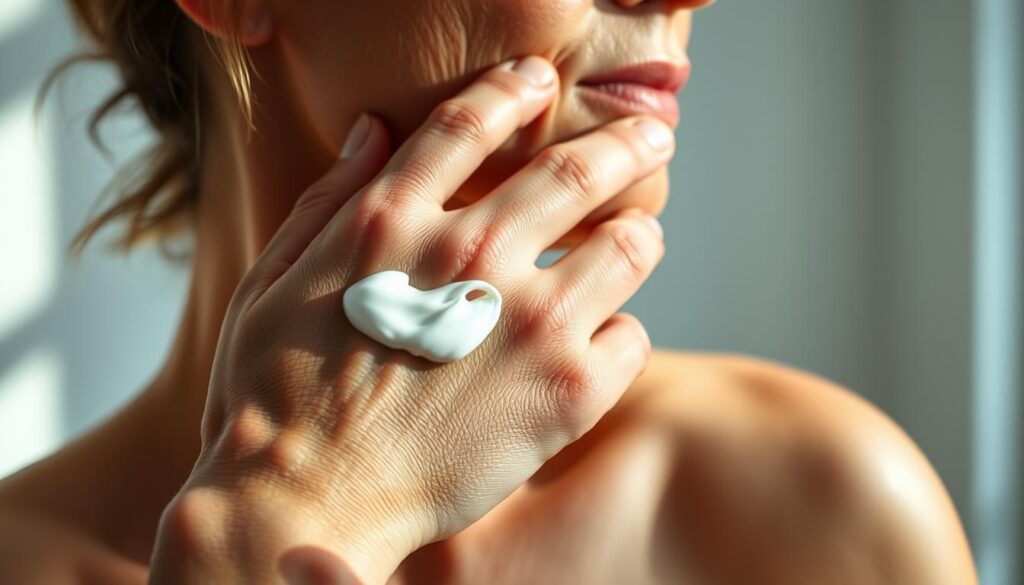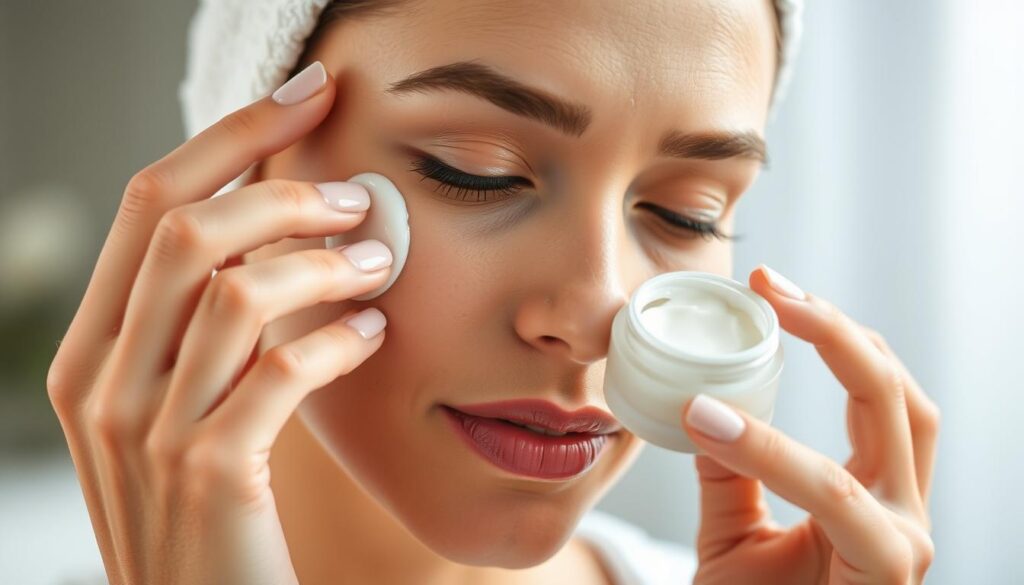Getting the most from your anti-wrinkle cream starts with knowing the right techniques. Many people miss out on full benefits because they don’t use best practices for application. This guide explains how to use science-backed best skincare techniques and wrinkle reduction methods to maximize results.
Discover how small changes in anti-wrinkle cream application can make a visible difference. This includes reducing fine lines and improving skin texture.
Key Takeaways
- Correct application methods boost product absorption and effectiveness.
- Upward strokes and gentle pressure improve ingredient delivery.
- Timing matters: applying at night enhances overnight skin repair.
- Preparation steps like cleansing boost anti-wrinkle cream performance.
- Targeted application on key areas like the forehead and eyes maximizes wrinkle reduction.
Understanding Anti-Wrinkle Creams and Their Benefits
Anti-wrinkle creams use anti-aging ingredients to fight signs of aging. They aim to lessen fine lines, enhance skin texture, and increase elasticity. Ingredients like retinol and peptides for wrinkles are crucial for their effectiveness.
- Retinol: Known for retinol effectiveness, it speeds cell turnover to smooth wrinkles. Buy on Amazon
- Peptides: Peptides for wrinkles signal skin to produce collagen, plumping lines over time.Buy on Amazon
- Hyaluronic Acid: Draws moisture to hydrate and fill in creases temporarily.Buy on Amazon
- Antioxidants: Neutralize free radicals that break down skin’s natural defenses.
“Peptides stimulate collagen production, making them a top choice for addressing early signs of aging,” says Dr. Jane Collins, a board-certified dermatologist.
Science backs up these ingredients’ benefits. Retinol boosts collagen, while peptides strengthen skin. Seeing results takes 8–12 weeks, so sticking to a routine is essential. Knowing how these ingredients work helps us understand why proper use is crucial.
Preparing Your Skin Before Application
Getting your skin ready is key for anti-wrinkle treatments to work well. Clean, exfoliated skin lets products soak in better. Follow these three steps to get the most out of your cream.
Cleansing Properly for Maximum Absorption
Cleaning your skin before applying anti-wrinkle cream gets rid of dirt. Use a pH-balanced cleanser like Cetaphil Gentle Skin Cleanser. Buy on Amazon This keeps your skin moist. Rinse with lukewarm water and gently pat dry—don’t rub.
- Choose fragrance-free formulas to prevent irritation
- Avoid bar soaps that disrupt the skin barrier
The Importance of Exfoliation
Exfoliating makes your skin smoother and helps products absorb better. Pick the right method for your skin type:
| Type | Examples | Best For |
|---|---|---|
| Physical | Jojoba beads, Konjac sponges | Normal/oily skin |
| Chemical | Glycolic acid, BHA pads (The Ordinary’s AHA 30% Peel) | Dry/sensitive skin |
Using Toner as a Prep Step
Applying toner balances your skin’s pH and readies it. Choose alcohol-free ones like Thayers Rose Petal Witch Hazel. Use it with a cotton pad in the morning and night to help your cream absorb better.
Tip:Find toners with hyaluronic acid Buy on Amazon for extra moisture.
Not prepping your skin can cut down on product effectiveness by up to 40%, studies show. Make sure to prep well for faster, better results.
Technique for Applying Anti-Wrinkle Cream for Best Results
Learning the right way to apply skincare is key. Here’s how to use anti-wrinkle creams for better results.
The Upward Stroke Method
Always use upward application strokes with light fingers. Start at the jawline and move up to the hairline. This helps fight gravity and lifts your skin.
Think of it as fighting against the pull of gravity. Every stroke helps keep your skin firm.
Gentle Tapping vs. Rubbing
Don’t rub your skin hard. Instead, use facial massage techniques like tapping. Press your fingertips gently and tap the cream into your skin.
This method helps the cream absorb better without stretching your skin. Rubbing can harm your skin, but tapping is safer.
Pressure Points for Anti-Aging
Focus on pressure points for anti-aging to get better results. Gently press on your temples, under your cheekbones, and along your jawline for 5 seconds each.
These spots improve blood flow, reducing puffiness and helping the cream work better. Use your ring finger for light pressure.
Using Application Tools
Tools like jade roller benefits can help a lot. Roll the jade roller from the center of your face outward. It cools your skin and boosts blood flow.
Gua sha stones can also help smooth out stubborn areas like the nasolabial folds. These tools are more than just tools—they’re part of your daily skincare routine.
A 2023 study in the Journal of Dermatological Science found that combining upward strokes with pressure points increases active ingredient penetration by 34%.—Dr. Elena Torres, Dermatologist
Be patient and precise with your skincare. Every technique works best when done regularly. Let your fingers guide the product, not push it too hard. Give your skin a spa treatment every morning and night.
Optimal Timing: When to Apply Your Anti-Wrinkle Products
Your skin repairs best at night. That’s why nighttime skincare routine steps like retinol boost collagen. In the morning, use antioxidants to protect against UV rays. Match your skincare to your body’s natural cycles.
- Morning Anti-Aging Routine: Cleanse, apply vitamin C serum, and finish with SPF 30+ sunscreen.
- Nighttime Skincare Routine: Double-cleanse, use retinol or peptides, then apply a nourishing moisturizer.
Seasonal changes affect your skin too. In summer, use more SPF. Winter needs richer moisturizers. Check labels for seasonal skincare adjustments tips.
Wait 20 minutes between products for full absorption. Don’t mix daytime and nighttime products. Always apply sunscreen last in the morning. Use retinol at night. Timing is key to matching your skin’s needs.
Targeting Problem Areas Effectively
Mastering zone-specific techniques can greatly improve anti-aging results. Here’s how to address four key zones with precision:
Under-Eye Application Techniques
The thin skin under your eyes needs gentle care. Use your ring finger to apply a small amount. Pat gently from the inside out, without pulling down. This under-eye wrinkle treatment Buy on Amazon helps prevent wrinkles and keeps the area hydrated.
Forehead and Brow Area Strategy
To reduce forehead lines, use upward strokes. Start at the temples and move towards the hairline, applying light pressure with your fingertips. Add 10-second massage circles between your brows to soften tension lines.
Neck and Décolletage Approaches
Neck skin, affected by gravity, benefits from upward strokes. Use a small amount, smoothing from the collarbone up. For neck anti-aging techniques, use light pinching motions to firm the jawline.
Smile Lines and Nasolabial Folds
For nasolabial fold treatment, apply a small amount of product. Use cross-hatch strokes: vertical then horizontal lines over the folds. Press with your knuckles along the jawline to help the product absorb better.
| Area | Technique | Key Tip |
|---|---|---|
| Under-Eye | Ring Finger Patting | 10 gentle taps daily |
| Forehead | Upward Glides | Avoid aggressive rubbing |
| Neck | Vertical Lifting | Apply AM and PM |
| Nasolabial Folds | Cross-Hatch Massage | 2 passes per session |
Layering Anti-Wrinkle Products with Other Skincare Items
Learning skincare layering techniques helps your anti-wrinkle cream work best. Start with thin products like serums or essences. Then, move to thicker creams and oils. This order helps avoid clogged pores and ensures active ingredients work well.
- Cleanser
- Toner
- Vitamin C or retinol serum
- Anti-wrinkle cream
- Moisturizer (if needed)
- Sunscreen (daytime)
Serum before moisturizer is key. Serums have small molecules that deeply penetrate. Moisturizers then keep hydration in. Be careful with retinol and AHAs. Use them 30 minutes apart or alternate days to avoid irritation.
“Layering isn’t just stacking products—it’s about creating a chemical harmony on your skin.” – Dr. Jane Carter, Dermatologist

Be patient. Wait 1–2 minutes between each step for absorption. If makeup pills, check your product absorption order. Thick moisturizers can cause makeup issues.
Use anti-wrinkle creams with hyaluronic acid serums for moisture. But, avoid oil-based primers. Always finish with sunscreen during the day. A good routine balances science and simplicity, making your skin happy.
Common Mistakes That Reduce Anti-Wrinkle Cream Effectiveness
Even the best anti-wrinkle creams can underperform due to simple oversights. Avoid these common skincare mistakes to avoid and boost results with small adjustments.
Using Too Much Product
Less is more when it comes to the proper cream amount. Squeezing out a large glob can overwhelm skin, causing breakouts or waste. Aim for a pea-sized dab for cheeks and a dime-sized dot for larger areas like the forehead.
Inconsistent Application
Sporadic use undermines progress. A consistent skincare routine ensures active ingredients penetrate over time. Try setting phone reminders or pairing steps with daily habits like brushing teeth.
Incorrect Order of Skincare Products
Layering out of sequence negates benefits. Always follow this order: cleanser → serum → moisturizer → SPF. Skipping this patient application techniques step traps ingredients beneath heavier products.
Rushing the Application Process
Rushing prevents absorption. Take 30–60 seconds to gently press cream into skin using upward motions. This patient application techniques lets ingredients work effectively.
| Mistake | Problem | Fix |
|---|---|---|
| Over-application | Clogs pores | Use pea-sized portions |
| Skip-and-go routines | Slows results | Set daily reminders |
| Wrong product order | Blocks absorption | Layer thin-to-thick |
| Rushed application | Poor distribution | Take 1 minute for even spread |
Adjusting Application Techniques for Different Skin Types
Your skin type greatly affects how anti-wrinkle creams work. Here are some tips to enhance your results:

- Dry Skin: Start with a dry skin anti-aging routine by misting your face with water. Then, gently press the cream into your skin with your fingertips. This helps keep moisture in and prevents oil loss.
- Oily Skin: For an oily skin wrinkle treatment, apply the cream in two steps. Pat it onto your T-zone and cheeks separately. Use less on oily areas to avoid clogged pores.
- Sensitive Skin: When dealing with sensitive skin application methods, always test first. Apply the cream with a cool jade roller. This method helps distribute the product smoothly without irritation.
- Combination Skin: To tackle combination skin techniques, divide your face into sections. Use a thicker cream on dry areas and a light serum on oily ones.
Remember, the seasons change, and so should your skincare routine. In winter, layer your products after using a humidifier to keep your skin hydrated. In summer, make sure your products are fully absorbed before applying sunscreen to avoid any residue.
Listen to your skin. Make adjustments every week based on how it feels. These small changes can make a big difference in your skincare routine.
Conclusion: Maximizing Your Anti-Wrinkle Cream Results
Your anti-aging skincare results depend on using wrinkle prevention techniques every day. Follow the steps like using upward strokes and applying pressure to key points. But, the real success comes from mixing these steps into a complete anti-aging plan.
Adding healthy habits to your routine helps your skin too. Sleep on your back to avoid wrinkles, drink water to stay moist, and use sunscreen every day. Eating foods like berries and leafy greens helps your skin, and yoga can reduce inflammation. These choices make your skincare plan stronger.
Remember, seeing changes takes time. Most products start to work in 8–12 weeks. Take monthly photos to track your progress. If you don’t see results fast, check how you’re applying the products and if you need to adjust your routine.
See each application as a chance to care for yourself. Applying products gently makes skincare a special moment. Small daily actions, combined with smart choices, lead to lasting beauty benefits. Your skincare isn’t just about creams; it’s about taking care of yourself, inside and out.

